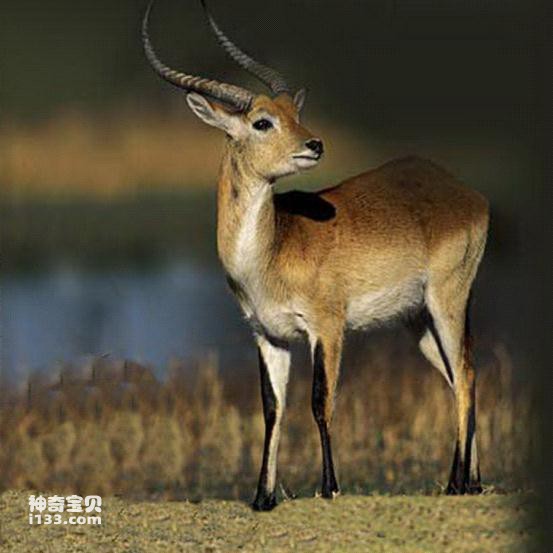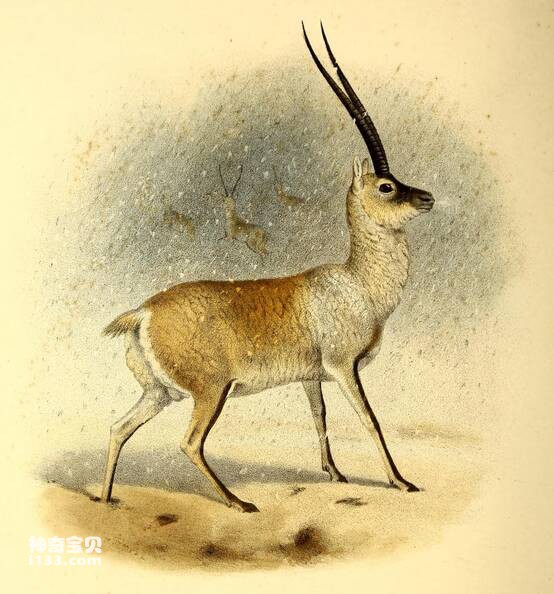The Tibetan antelope, whose scientific name is Tibetan antelope, is the only species of the genus Tibetan antelope in the order Artiodactyla, Bovidae, subfamily Antelope. The earliest scientific description of the Tibetan antelope was made by the British naturalist Clarke Abel in 1826, but he died in November of the same year before he could name it. It was later described by the British naturalist Brian Hodgson ( Named in 1834 by Brian Houghton Hodgson.
The back of the Tibetan antelope is reddish brown, and the belly is light brown or off-white. Adult male Tibetan antelopes have black faces, black markings on their legs, and harp-shaped horns on their heads for defense against enemies. Female Tibetan antelopes have no horns. The undercoat of the Tibetan antelope is very soft. An adult female Tibetan antelope is about 75 centimeters tall and weighs about 25 to 30 kilograms. Males are about 80 to 85 centimeters tall and weigh about 35 to 40 kilograms. Tibetan antelopes become sexually mature at the age of 2. The male life span is generally no more than 8 years old, and the female life span is generally no more than 12 years old. It can last up to nearly 10 years in captivity. The Tibetan antelope's habitat is 3,250 to 5,500 meters above sea level, and it is most adapted to flat terrain at an altitude of about 4,000 meters.

Tibetan antelopes mainly inhabit alpine meadows, alpine meadow grasslands, alpine desert steppes and alpine deserts at an altitude of 4000-5000 meters, all of which are inaccessible places. The vegetation there is sparse and mainly grows stipa grass, moss and lichen plants, which are the main food for Tibetan antelopes to survive. In nature, wolves, brown bears, lynxes, snow leopards, golden eagles and alpine vultures are their main natural enemies. In the harsh natural environment of the plateau, in order to find enough food and resist the severe cold, after long-term adaptation, the Tibetan antelope has formed the habit of migrating in groups, and has a layer of downy hair on its body that is extremely warm. Tibetan antelope, wild yak, and Tibetan wild donkey are known as the "three major families" of the northern Tibetan Plateau and are a flagship species of the Qinghai-Tibet Plateau.
The Tibetan antelope is a unique species in China. According to the research of German-American wildlife biologist George Schaller, it can be roughly divided into several non-migratory populations and four major migratory populations. Mainly living in the Qinghai-Tibet Plateau and the Altyn Mountains of Xinjiang, the distribution area is roughly centered on the Northern Tibetan Plateau (Qiangtang), south to the north of Lhasa, north to the Kunlun Mountains, east to the northern Qamdo area of Tibet and southwestern Qinghai, and west to central China On the Indian border, a small number occasionally flow into the Ladakh region of Indian-controlled Kashmir. Tibetan antelopes were still distributed in Nepal until the first half of the 19th century, and then became extinct. The Tibetan antelope was listed in Appendix II of the Convention on International Trade in Endangered Species of Wild Fauna and Flora in 1975. In 1979, it was listed in Appendix I of a species with strictly prohibited trade. In 1988, the "List of National Key Protected Wild Animals" issued in 1988 established it as a national species. First-level protected wild animals. The Tibetan antelope is recognized as a typical representative of the fauna of the Qinghai-Tibet Plateau and an important indicator species of the natural ecosystem.

The Tibetan antelope is a very ancient species. The ancestors of the Tibetan antelope can be traced back to the Qurliqnoria (Qurliqnoria) distributed in the Qaidam Basin in the late Miocene Epoch (about 25 million years ago). The fossil of this animal has a straight and straight body similar to that of the Tibetan antelope. Upward corner center. Fossils of Pantholops hundesiensis, an extinct Pleistocene species that belongs to the same genus as the Tibetan antelope, were discovered in the high-altitude area of Niti Pass on the Sino-Indian border [3]. The "Yang Sheep" recorded in the ancient Chinese mythology "The Classic of Mountains and Seas" is very similar to the Tibetan antelope. Modern Tibetan antelopes are much larger than their ancestors tens of millions of years ago. Ten million years ago, the Himalayas ushered in a strong orogeny. The forests in northern Tibet disappeared. Various animals either fled for their lives or accelerated their evolution. The native species Tibetan antelope, wild yak, and Tibetan wild ass have always stayed here. About 10,000 years ago, the altitude of northern Tibet rose again, and the climate became colder and drier. During the long-term evolution process, the Tibetan antelope showed the characteristics of adapting to the high cold and low oxygen environment in both morphology and body. Today, the northern Tibetan Plateau, located in subtropical latitudes, has high altitude, sufficient sunlight, and thin air, and the Tibetan antelope has become the dominant species here. In order to breathe more oxygen, the mouth of the Tibetan antelope is very wide, the nasal cavity is enlarged and the sides are bulging to increase the air contact surface. The quality of Tibetan antelope's hair is recognized around the world, and this has become the main reason why they are poached. Those hollow structures of down are densely covered on the body, which can insulate from heat in the sun and protect against wind and cold during snowstorms. From June to October every year, the long moulting period begins, creating a rhythm of warm winter and cool summer, as if it has its own blanket-type air conditioner. In order to avoid predators such as wolves, lynxes, and snow leopards, Tibetan antelopes can run at an average speed of 80 kilometers per hour. Especially when the bones of Tibetan antelope calves are calcified only three days after birth, they can run faster than wolves. In addition, Tibetan antelopes are accustomed to moving in groups, especially during seasonal migrations where thousands of sheep often advance and retreat together, which can also reduce the risk of being predated.
The origin of the Tibetan antelope provides another interesting example of an endemic species on the Tibetan Plateau, with ancestry dating back to the late Miocene. In the Qaidam Basin in the northern part of the Qinghai-Tibet Plateau, the Qurliqnoria is an extinct bovid animal with straight and upward horn centers. It has always been considered the ancestor of the Tibetan antelope. A broken horn core of Kuyang was also found in the early Pliocene strata of the Zanda Basin. Importantly, late Miocene mammals in the Qaidam Basin have begun to show a certain level of localization. Some special bovine animals, such as Tsaidamotherium, Olonbulukia, Ku sheep, Tossunnoria, and a kind of pronghorn deer, are almost exclusively distributed in the Qaidam area. Pantholops hundesiensis, an extinct Pleistocene species of Tibetan antelope, was discovered in a high-altitude area near the Niti Pass on the China-India border. Assuming that the Ku sheep and Tibetan antelope are as closely related as their horn-centred morphology indicates, the Tibetan Plateau origin of the Tibetan antelope is quite plausible.
animal tags:
We created this article in conjunction with AI technology, then made sure it was fact-checked and edited by a Animals Top editor.